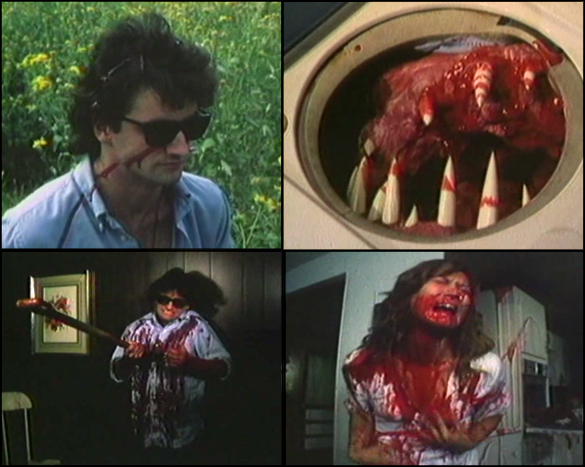Part 1
Part 2
 Alice (Czech: Něco z Alenky) is a Czech surrealist fantasy film by Jan Švankmajer. It retells Lewis Carroll's first 'Alice' book, Alice's Adventures in Wonderland, in Švankmajer's unique style. The film combines live action with stop motion animation. Alice is played by Kristýna Kohoutová, and the English dubbed version features the voice of Camilla Power. The movie is considered a cult movie.
Alice (Czech: Něco z Alenky) is a Czech surrealist fantasy film by Jan Švankmajer. It retells Lewis Carroll's first 'Alice' book, Alice's Adventures in Wonderland, in Švankmajer's unique style. The film combines live action with stop motion animation. Alice is played by Kristýna Kohoutová, and the English dubbed version features the voice of Camilla Power. The movie is considered a cult movie. This retelling of the "Alice" story is continually ambiguous about whether or not Alice is in her real world, or when exactly she crosses over to the "Wonderland". Early in the film, Alice appears to be in her bedroom, when a stuffed rabbit display comes to life and breaks out of its cage. Alice follows it up a large, rocky hill and into the drawer of a writing desk. This leads to a cavern where soon after spying the White Rabbit eating sawdust from a bowl with a spoon, she trips and falls through a bucket and seemingly down an elevator. "Wonderland" itself is a strange mix of a household-like areas with very little concern for logical space or size. Its inhabitants tend to be strange mixtures of rubbish and dead animals, such as a bed with bird legs, or a stuffed lizard with glass eyes.
This retelling of the "Alice" story is continually ambiguous about whether or not Alice is in her real world, or when exactly she crosses over to the "Wonderland". Early in the film, Alice appears to be in her bedroom, when a stuffed rabbit display comes to life and breaks out of its cage. Alice follows it up a large, rocky hill and into the drawer of a writing desk. This leads to a cavern where soon after spying the White Rabbit eating sawdust from a bowl with a spoon, she trips and falls through a bucket and seemingly down an elevator. "Wonderland" itself is a strange mix of a household-like areas with very little concern for logical space or size. Its inhabitants tend to be strange mixtures of rubbish and dead animals, such as a bed with bird legs, or a stuffed lizard with glass eyes. Some characters from the original Alice's Adventures in Wonderland appear in similar, but Švankmajerian, forms. Such as a wind-up toy rabbit for the March Hare, or a sock with glass eyes for the Caterpillar. Similarly, several sequences from the original story, such as Alice's growing and shrinking via the consumption of unusual food and drink, or the scene in which a crying baby changes into a pig, are portrayed in original forms. For example, when Alice shrinks, she is transformed into a doll which looks fairly similar to her regular self.
Some characters from the original Alice's Adventures in Wonderland appear in similar, but Švankmajerian, forms. Such as a wind-up toy rabbit for the March Hare, or a sock with glass eyes for the Caterpillar. Similarly, several sequences from the original story, such as Alice's growing and shrinking via the consumption of unusual food and drink, or the scene in which a crying baby changes into a pig, are portrayed in original forms. For example, when Alice shrinks, she is transformed into a doll which looks fairly similar to her regular self.The movie also contains a number of original sequences not related to the original novel. In one such sequence, Alice is trapped inside a doll-like shell, after being made to walk into a bowl of milk while in her shrunken form, and is locked in a food closet. The Queen's character is also changed somewhat, in that her execution sentences are carried out, by the White Rabbit with a pair of scissors.
When the movie ends, it is ambiguous whether everything that happened to Alice was indeed real, or if she is still dreaming. She wakes in her room, but then finds that the white rabbit is still missing from his cage, and finds a secret compartment where he keeps his scissors. She ponders whether or not she will cut his head off.
Alice trapped inside a dollhouse after growing too large to escape.
 The visuals are often described as grotesque, perverse, or disturbing, but overall not repulsive. Prominent is the stuffed white rabbit, whose chest is constantly leaking so that he has to keep eating sawdust, and various animated skulls and slabs of raw meat products. As mentioned previously, many of the animated characters are made of surprising household objects. There are a number of visual puns. Scissors and knives are also recurring themes. It should also be noted that all dialogue is narrarated in third person by a large mouth.
The visuals are often described as grotesque, perverse, or disturbing, but overall not repulsive. Prominent is the stuffed white rabbit, whose chest is constantly leaking so that he has to keep eating sawdust, and various animated skulls and slabs of raw meat products. As mentioned previously, many of the animated characters are made of surprising household objects. There are a number of visual puns. Scissors and knives are also recurring themes. It should also be noted that all dialogue is narrarated in third person by a large mouth.Download links: 1 2 3 4 5 6 7 8 Pass: www.AvaxHome.ru



































